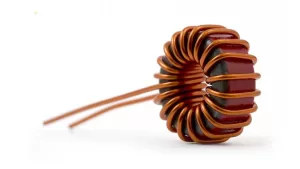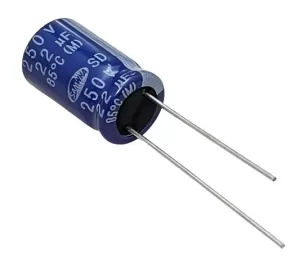
Inductors vs Capacitors: A Comparative Analysis of Energy Storage
December 18 2023  1266
1266
Inquiry
Global electronic component supplier AMPHEO PTY LTD: Rich inventory for one-stop shopping. Inquire easily, and receive fast, customized solutions and quotes.
QUICK RFQ
ADD TO RFQ LIST
In this blog, we will conduct a comparative analysis of inductors and capacitors, exploring their differences, inner workings, applications, and historical significance.
What is an Inductor?
An inductor is a passive electrical component that, when current passes through it, stores energy in a magnetic field. Its capacity to store energy in the form of a magnetic field is measured by its inductance, which is what distinguishes it.
Types of Inductors
There are several types of inductors, each designed for specific applications and operating conditions. Some common types of inductors include:- Air Core Inductors: These inductors only rely on the magnetic field produced by the current passing through a coil of wire that has no core. They are frequently employed in high-frequency applications where magnetic interference from a core material shouldn't occur.
- Iron Core Inductors: These inductors have a ferromagnetic core composed of ferrite or iron. Their high magnetic permeability makes them useful for energy storage and filtration in power supplies, transformers, and inductors.
- Toroidal Inductors: The donut-shaped core of these inductors enables effective containment of magnetic flux. Because of their small size and low electromagnetic interference, they are frequently found in power supplies, audio equipment, and electronic filters.
- Choke Inductors: They are intended to allow direct current (DC) or low-frequency AC to flow through while blocking high-frequency alternating current (AC). They are frequently used to remove undesirable noise and ripple from power supply circuits.
- Coupled Inductors: Often referred to as "transformers," these inductors are made up of two or more magnetically coupled inductors. In electronic circuits, they are utilized for isolation, voltage transformation, and impedance matching.
- Multilayer Inductors: To obtain larger inductance values in a compact form factor, these inductors are built utilizing many layers of conductive material, usually arranged in a spiral or helical pattern. They are frequently utilized in high-frequency applications and integrated circuits.
Are Inductors Polarized?
Unlike capacitors, inductors are not polarized, meaning they can be connected in either direction in a circuit without affecting their functionality. Understanding the non-polarized nature of inductors is crucial for interpreting circuit diagrams and designing electronic systems.What is a Capacitor?
A capacitor is a passive two-terminal electronic component that stores and releases electrical energy in an electrical field. It is made up of two conductive plates divided by an insulating substance known as a dielectric. An electric field is created when there is a voltage differential between the plates, which causes the capacitor to store energy as an electrostatic field.
Who Invented Capacitors?
The idea of a capacitor dates back to the 1740s, and several scientists, including Ewald Georg von Kleist, Pieter van Musschenbroek, and Alessandro Volta, independently created the capacitor's current form.Video related to Capacitors
What is the Difference Between an Inductor and a Capacitor?
| Feature | Inductor | Capacitor |
| Energy Storage | Magnetic Field | Electric Field |
| Opposes Change | Current | Voltage |
| Applications | Power conversion, filtering, transformers, motors, tuning | Smoothing power, filtering, timing, memory, decoupling |
How Inductor Works?
The electromagnetic induction principle underpins the operation of an inductor. An inductor creates a magnetic field around itself as electricity passes through it. Magnetic flux is the form of energy stored in this magnetic field. The square of the current and the inductor's inductance determines how much energy is retained in the magnetic field. The magnetic field surrounding the inductor varies in tandem with variations in the current flowing through it. This shift in the magnetic field causes an electromotive force (EMF), or voltage, to be induced in the inductor, by Faraday's law of electromagnetic induction. The inductor resists any abrupt changes in the current flow because the induced voltage opposes the change in current. Essentially, an inductor stores and releases energy in its magnetic field to resist variations in current flow. Because of this characteristic, inductors can be used for a wide range of tasks, such as energy storage, frequency filtering in circuits, and producing inductive reactance in AC circuits. An inductor's inductance, expressed in henries (H), determines how it behaves. An inductor's inductance depends on a variety of variables, including the coil's length, permeability of the core material (if any), and number of turns of the coil.How Capacitors Work?
- Charging the Plates: Positive charges build up on one plate and negative charges collect on the other when the capacitor is connected to a voltage source. This pushes the charges apart by creating an electric field between the plates.
- The Opposing Force: The electric field gets stronger as charges accumulate. Additional charging is resisted by the opposing force of this expanding electric field. When the capacitor eventually achieves its maximum capacity, a stable condition is produced by the electric field and voltage source being in balance.
- Energy Storage: The insulator keeps the charges apart even after the power source is disconnected. The capacitor functions as a little battery thanks to the electrical energy that is stored inside the electric field.
- Discharging the Energy: The capacitor's stored energy wants to go back and forth when it is connected to a circuit. A current flows and the stored energy is released when the positive charges on one plate rush towards the negative charges on the other. Depending on the characteristics of the circuit and capacitor, this discharge may occur suddenly or gradually.
How Does an Inductor Store Energy?
Inductors store energy in the form of a magnetic field. The inductor generates a magnetic field that stores energy as current passes through the wire coil. Many electronic devices use inductors for energy storage and transfer because they allow the stored energy to be released back into the circuit when the current changes.How Capacitors Store Energy?
Energy is stored in capacitors by creating an electric field between their plates. A capacitor's capacity to store energy is directly correlated with the square of the voltage applied across it. Capacitors are crucial components of electronic circuits for signal processing and energy storage because they store energy that may be released back into the circuit when needed.Where Inductor is Used?
- Power Supplies: To reduce unwanted noise and output voltage ripple, inductors are employed in power supply circuits. They frequently act in tandem with capacitors as part of a filtering network to produce a steady and smooth DC output.
- Signal Processing: Inductors are employed in speaker crossovers in audio equipment to route certain frequency ranges to the right speaker drivers. They are also employed in audio signal filters to eliminate undesirable frequencies.
- Radio Frequency (RF) Circuits: Inductors are necessary for impedance matching, tuning, and filtering in radio frequency (RF) circuits. They regulate frequency response and signal transmission in radio receivers, transmitters, and antennas.
- Transformers: The main parts of transformers, which are utilized for electrical isolation, impedance matching, and voltage transformation, are called inductors. Transformers are extensively utilized in electronic gadgets, electrical equipment, and power distribution.
- Oscillators and Timing Circuits: Inductors and capacitors work together to produce oscillators and timing circuits. Devices like clocks, timers, and electronic oscillators, aid in controlling the frequency and timing of electrical impulses.
- Motor Control: To help safeguard the motor and regulate its speed, motor control circuits use inductors to limit the rate at which the current changes.
Where Capacitors Are Used?
- Energy Storage: Electrical energy is stored in capacitors and released as required. They are frequently found in defibrillators, different energy storage devices, and camera flash units.
- Power Conditioning: To reduce voltage ripples and fluctuations, power supply circuits employ capacitors. They contribute to the stabilization of the DC voltage and enhance the general effectiveness and functionality of the power supply.
- Timing Circuits: To regulate the timing of signals and events, timing circuits employ capacitors. They are necessary parts of clock, timer, and oscillator circuits.
- Signal Coupling and Decoupling: Capacitors are employed in electrical circuits for coupling and decoupling AC signals between various stages. They maintain signal integrity and amplification by permitting the passage of AC signals while obstructing DC components.
- Filtering: Electronic filters employ capacitors to let through some frequencies and prohibit others. They aim to filter out undesirable noise and interference from audio devices, radio receivers, and communication systems.
- Tuning Circuits: Radio receivers, oscillators, and other electrical equipment can have their frequency response adjusted with the use of capacitors. The resonance frequency of tuned circuits must be adjusted with their help.
Conclusion
In conclusion, both inductors and capacitors are essential parts of electronic circuits, each with special qualities and uses. We have learned more about these crucial electronic components' inner workings, historical significance, and useful uses by comparing and contrasting them. It is essential to comprehend the distinctions and overlaps between inductors and capacitors when creating dependable and effective electronic systems. The future of technology will continue to be greatly influenced by inductors and capacitors as long as the field of electronics continues to progress.Populer Posts
STA-4110
Stancor Corporation
DT090P6-360-V-2
Autec
DTEA1030C1
Wall Industries
DT-M090-190-V-5
Autec
AEH130PS36
XP Power
APS60ES-33
Advanced Power Solutions
SDM36-12-U-ST
CUI Inc.
APS61ES-10
Advanced Power Solutions
68-950-1
Mode Electronics Ltd
PLW1947N7
Tamura
HES10-09007-F-6G
HiTRON Electronics
WMEA1019AHU
Wall Industries
